PART 1
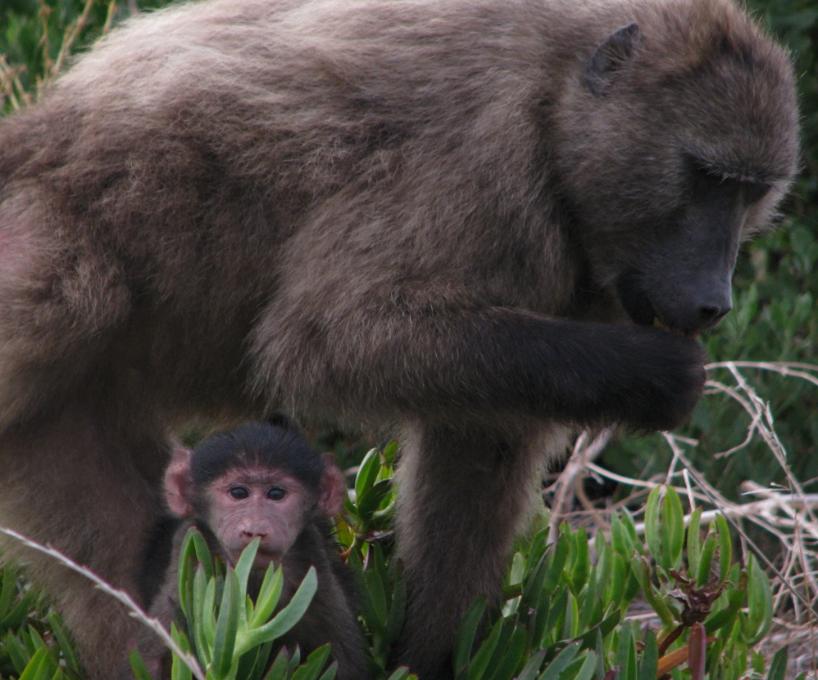
Standing in a residential area, a baby Chacma baboon and mother {Tammy} whose leg was amputated after being shot. Tammy is one of a number of baboons hurt or injured by residents. Since 2009 baboons have come under additional threat due to controversial culling protocols introduced in 2009 and 2010 with criteria including coming into urban space and "raiding".
For over a decade the Peninsula baboons have been the only legally protected baboons in the country. Elsewhere they are killed with impunity including for raiding.
2010-2011
A second more stringent culling protocol
targets Cape Town's Chacma Baboons
The Cape Peninsula's small free ranging baboon population was previously threatened by residents' actions, lack of funding for the monitor program.
This was followed in June 2010 by an even further reaching culling protocol targeting individual raiders as well as other categories. It was not made available to members of the public requesting it until November 2011 when placed on the CapeNature website.
Alpha male {Quondi} with female and baby. The male is eartagged in terms of the protocols for raiding behaviour. The collar can transmit details of his raiding pattern which information can be used if motivating for his culling to WAC, the Wildlife Advisory Committee of CapeNature that makes its decision based on data and information presented to it by others. These include NCC, the monitor service provider, BRU, a baboon research unit, also a founding member of a residents' group both having a foundational goal for the total removal of baboons from urban areas. Residents' affadavits are also used (which may include statements by those who want baboons removed.) WAC members have no contact with the animals themselves.
WHAT WILL HAPPEN TO
CAPE TOWN'S
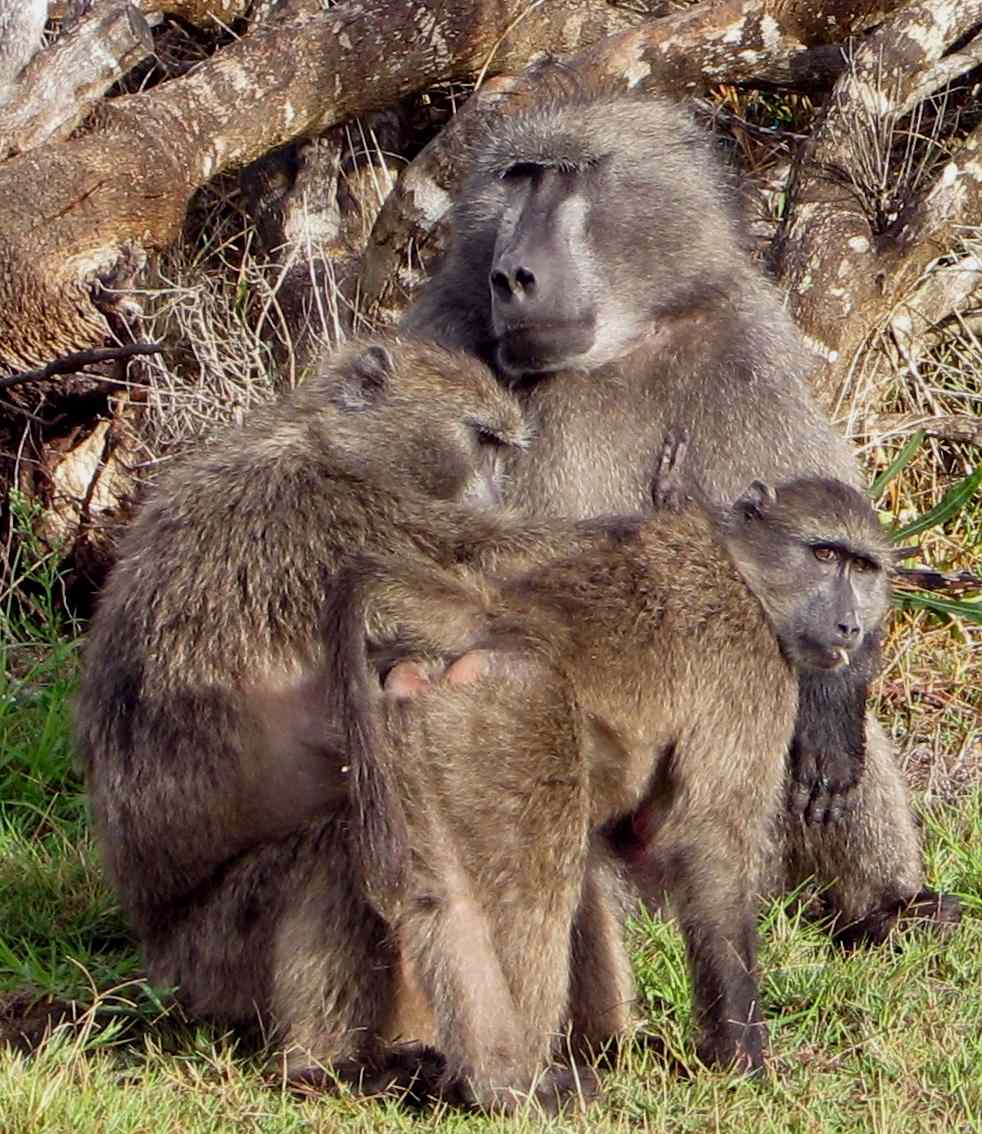
An alpha male Cape Chacma baboon {Peter} with female {Crookie} and juvenile female. Not long after this photo was taken, the young 18 month old female was shot in a resident's garden as she sat sitting eating something. The adult female's misshapen hand is also thought to be a result of a human induced injury,
Although baboon numbers stabilised during Baboon Matters tenure as service provider and the male to female ratio began to normalize, the question has been asked why with troops already suffering high attrition rates due to human induced injuries, and with numbers that remained at little over 350 for a decade, it was necessary to introduce culling protocols in 2009 and 2010 - especially in view of the fact they have been criticized by independent scientists and experts as scientifically flawed and biased against the baboons.
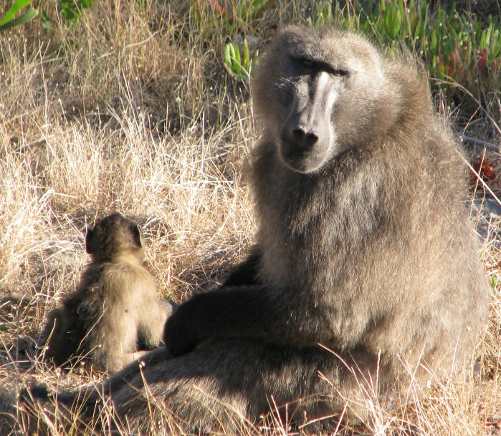


Alpha male baboons {Quizzy and Peter} with young. Chacma males make excellent fathers, are tolerant and protective of the young.
The Peninsula's baboons have, since 1998, had protected status with stiff penalties in place for residents hurting them. However, virtually no prosecutions have occurred. Baboons have been shot, ridden over, poisoned, trapped, whipped, had dogs set on them.
Since 2009 they are under additional threat from culling protocols. Several male baboons have already been culled – in less than 4 months, between 25 March and 15 July at least 3 were culled in terms of the protocols. Another dispersing male, TK7 was culled in November, 2011.
Male baboons are eartagged, the first step in the culling protocols. (Since April 2011, females and some males have also been tagged, ostensibly in terms of a research study into potential cross transmission of disease.) Cross transmission of pathogens was given by Dr O'Riain of BRU as a reason for killing Bart, the first baboon, targeted by the 2009 protocol, although primatologist Dr Tim Newman, at the time also a member of the Baboon Management Team) questioned this reasoning in a nationally broadcast TV programme.
See transcript of M-NET Cart Blanche TV interview at
http://beta.mnet.co.za/carteblanche/Article.aspx?Id=3762
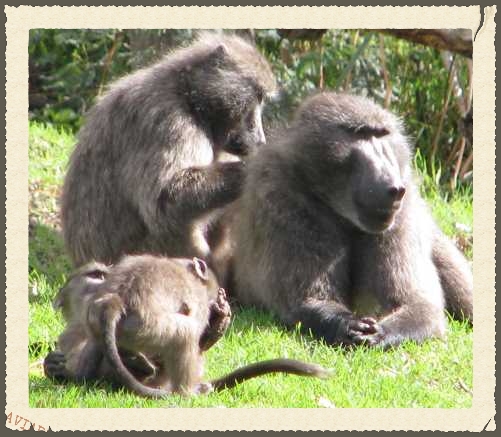
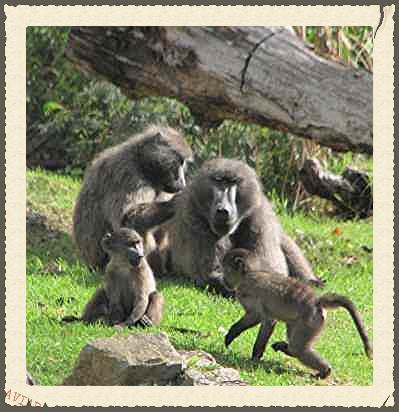
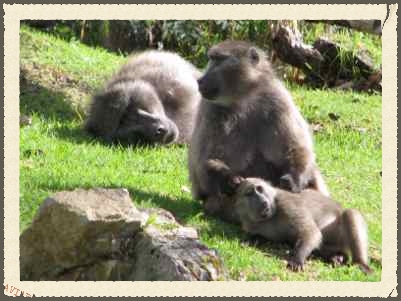
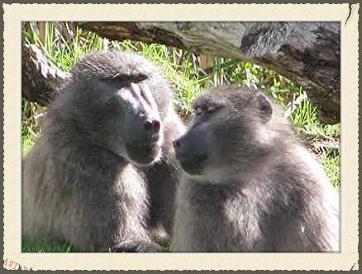
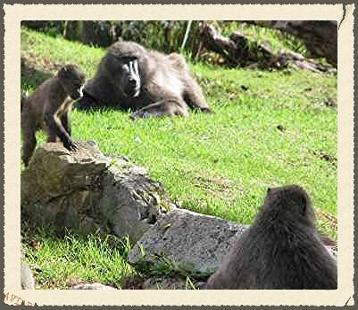
Female baboon grooms male baboon {Sebastian} as youngsters play. Grooming helps remove parasites and is also a form of social bonding. Males fight for dominance in the troop's hierarchical structure, giving preferential rights to food, females and grooming. The male above, Sebastian, was found dead in November 2010. The initial result of the post mortem was given as broncho pneumonia, but the actual cause of death has to date not been disclosed.
Photo of William and Angelina Ballerina by Baboon Matters All rights reserved
William of Scarborough sits with his sister Angelina Ballerina, one of the three baboons who died a painful death after poisoning from dieldrin in 2006. Jenni Trethowan of Baboon Matters, the monitoring service provider until August 2009, became severely ill after handling the sick baboons,and was admitted to the ICU.
William was the first baboon killed in terms of the 18 June 2010 "individual raider" protocol which could be potentially used to target baboons not only for "raiding" or eating available human derived food, but for entering unsecured property where people are eg houses and cars, as well as other criteria.
The individual raiders' protocol was for more than a year not made available upon requests from the general public, as according to some officials residents could use it against the baboons. Some have indeed done so, claiming baboons were "aggressive" or that they were "traumatized" by a baboon. Although adopted in June 2010, it was published on the internet on the CapeNature website in November 2011.
Following Wiliam's death, there was an outcry from residents who were not informed of the intention to lethally dart him. Some Scarborough residents saw him being trapped for euthanizing but were told by the monitoring service provider that the batteries on his collar were merely being changed.
William had moved from his natal Da Gama Park troop and joined the Slangkop or Kommetjie troop. According to Jenni Trethowan, William's sister, Angelina Ballerina, was given the name after her skull was fractured earlier in 2006 causing her to spin like a ballerina when attempting to walk. (The injury was suspected to be a result of residents' actions.) During a severe thunderstorm Angelina left the Da Gama Park troop and managed to locate her brother William in the Kommetjie troop.
After Angelina's death, William left this troop and two months later arrived in Scarborough. Some residents there regarded him as a "problem animal" (but at the same time failed to properly secure properties which would have prevented him from raiding) and motivated authorities for his culling. Others regretted a healthy animal had been euthanized in terms of the new protocol.
Some residents in the area, upset by the decision to cull him, held a memorial for him. Residents reported William's females and young calling for him for days. Culling causes troop disruption and can result in infanticide as well as increased fights to establish dominance following the death or removal of a troop leader.
While William was the first baboon culled in terms of the protocol above, Sol had been the first baboon culled in terms of the dispersing male protocol. It had not been made public at the time.
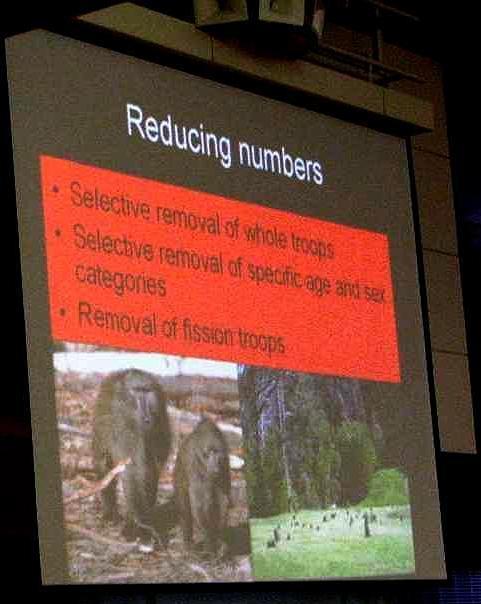
Although baboon numbers had remained relatively constant over the previous decade reaching little over 350, on 2 July 2009, reducing numbers and "selective removal" i.e. "culling" of baboons including whole troops was first mentioned to the public during a presentation by the head of the baboon research unit BRU at a baboon expert workshop. BRU would play a role in a number of the controversial changes and strategies, also giving input at various levels.
Not long after the July workshop, following change of baboon monitoring management in August 2009, a protocol headed "Action plan for Peninsula dispersing males and repeat raiders - prepared by BRU August 2009" - was put into place. It targeted healthy young males who leave or disperse from the troop and may enter into the urban area and raid unsecured properties.
Ear-tagging occurred on the 1st capture. From the 2nd to 4th capture, the protocol allowed for the baboon to be "euthanized" - the word "cull" was avoided by BRU (and subsequently by the Baboon Liaison Group (BLG) of which it became a founding member in early 2010 after the dissolution of the Baboon Management Team (BMT).
However, the public were under no illusion that the presentation had referred to baboons being culled i.e. "selectively removed" and killed. Newspaper reports on the workshop also addressed the fact that culling had been mentioned.
(Castration and sterilisation were options given in the protocol for the 2 and 3rd captures. Despite it being stated by the City vet at a public meeting in October 2011 that sterilisation would not be used as it had negative effects on troop members, on 15 November one of the two males of a fission troop, Carpenter, the younger of the two males of the Da Gama Park fission troop was castrated. Reports followed that a Tokai male had been castrated in December. AP O'Riain of BRU had been reported in the People's Post on 15 November saying that BRU would "make recommendations to implement contraception methods" in the Da Gama Park troop.)
The threat of baboons being killed in terms of the protocols became more evident when (during the 2010 World Cup) an even further-reaching Protocol for individual raiding baboons was adopted on 18 June, 2010, now targeting "individual raiders" as well as other categories. The introduction of protocols was seen by some as an attempt to override the Peninsula baboons' legally protected status.
William was lethally darted on 2 July 2010 by the city vet in terms of the new protocol called "Protocol for reducing the frequency and severity of raiding behaviour by chacma baboons on the Cape Peninsula, South Africa". His death occurred on the anniversary of the presentation regarding culling at the baboon expert workshop that also advocated removal of fission troops (pictured above). While members of the public regarded him as an alpha male, William was referred to by the monitoring service provider, NCC, as the leader of a fission troop, one of the groups also targeted by the new 2010 individual raider protocol.
After William's culling certain media stories focused on some Constantia residents' claims of their dogs being killed by baboons, ignoring the fact that baboons are regularly killed by dogs, including one ex-alpha male that was mauled and seriously injured by dogs and euthanized on the same day William was culled. (In October 2011, George the former alpha male of the Da Gama troop was killed by dogs. He was well known to residents and people who had seen him on Baboon Matters' walks. The walks were forced to be cancelled earlier in the year due to not being allowed on SANParks land. The book "Beast or blessing" was dedicated to George. Instead of reporting on his death, two days later the major local papers, and some international ones ran front page photos of baboons raiding cars at Cape Point. George's father, Eric, the oldest and best known baboon on the Peninsula, with a children's book written about him would go missing from the end of November, 2011.)
There would subsequently be a dispute about the status of Fred of Smitswinkel who was believed to be the alpha male by a number of individuals who had followed Fred over the course of the years.
An ITV production "Baboons with Bill Bailey", made around December 2010, not long before Fred's death, referred to him throughout as the alpha male. (The status of alpha male was ostensibly a mitigating factor of the "individual raider" protocol against being culled. Some complained this had been ignored, but learned that a single mitigating factor, even being alpha male, was not enough to prevent the animal from being culled.)
The monitoring service provider NCC, claimed Fred had acted aggressively to its staff, who were scared of him. However, it has been stated that the monitors and field managers have not received proper training in handling the baboons, some of them admitting that they were eager for training. (Around May 2010 one NCC director, had in fact seemed amenable to allowing the monitors to be trained by Baboon Matters should NCC get the long term contract, which they did later that year. In early 2011 Baboon Matters demonstrated they were able to move the baboons out the Kommetjie area the NCC monitors had been struggling to for days, yet they were not employed to help. At a meeting for residents convened by the CIty, Jenni Trethowan issued a challenge to first train the monitors to be assertive using Baboon Matters' methods before using aggressive "tools." )
It is of note that this Smitswinkel troop have at various times including during December 2010 been exposed to bullwhips and bearbangers which have consistently been advocated by the head of the research unit since 2009, despite censure of the methods by the SPCA and NSPCA.
As alpha, Fred would have been the focus of attention. In the same month he was killed, there was a complaint from a member of the public that a bear banger was set off next to Fred as he sat in a car. Bearbangers make two loud bangs and produce a flare like flash. A bullwhip can create the sound of a small sonic boom but also carries the risk that it can injure a baboon, even accidentally.
In October 2011, following permission granted by WAC for a trial, paintballs were used on a troop in Constantia. (It was reported by some that NCC would be training monitors in paintball markers.) The City vet stated they would be used in areas where residents gave approval. However, the SPCA has stated it is not up to residents to give approval. An eyewitness reported the frightened baboons not knowing where to run to. (While residents have consistently been assured bullwhips and bearbangers are for noise aversion, paintballs are a definite pain aversion technique.)
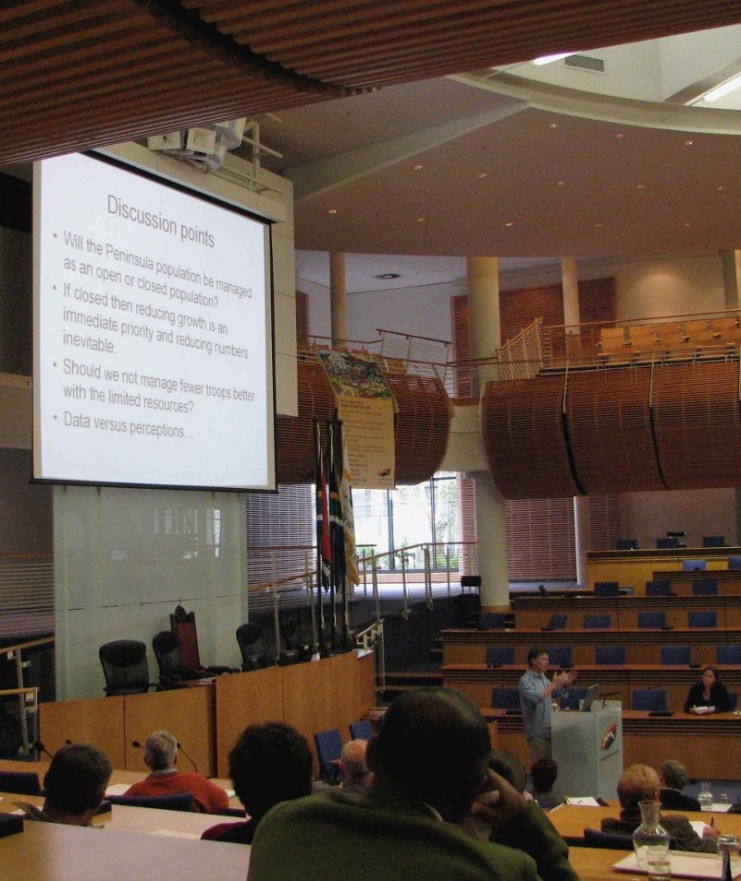
Dr Justin O'Riain presents his discussion points at the baboon expert workshop in 2009. In 2011, after a number of his recommendations have been adopted, some are concerned that reducing numbers, selectively removing whole troops and managing fewer troops could be another of his management recommendations adopted.

Some of the controversial and experimental recommendations given during the head of BRU's presentation including reducing numbers of baboons and alien plant growth (eg pines used for food by a number of baboons). Recommendations including collars, virtual barriers eg "holding the line", provisioning, electric fencing, bear bangers and bull whips made by him have subsequently also been the subject of controversy. With more baboons said to be tagged for research into disease cross-transmission, some have voiced the opinion that the Peninsula's Chacma baboons are becoming an open air laboratory. An application for bear banger research by BRU was turned down by the NSPCA ethics committee.
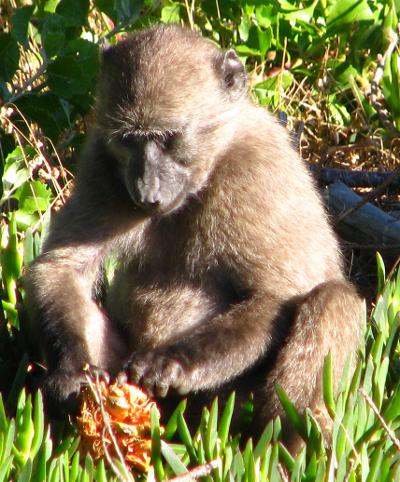


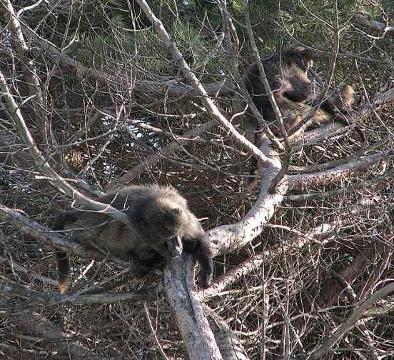
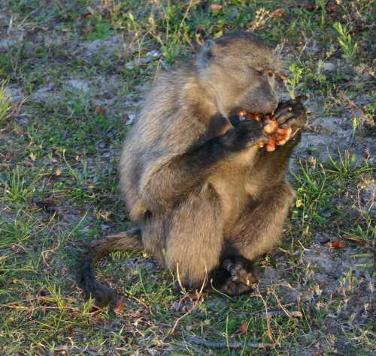
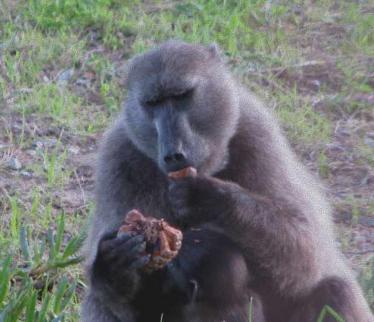
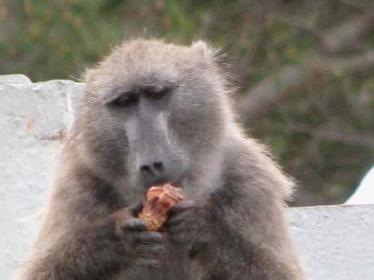
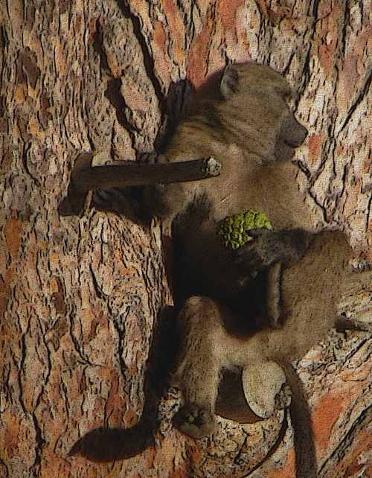
Baboons in pine trees and with pine cones. Note paint from paintball on leg of female with juvenile. Residents have used paintballs and pellet guns on the baboons, residents report projectiles narrowly missing them. Some report their pets being shot.
Pine trees provide sleep sites, protection and food. Baboons can spend long periods of time engaged in cracking open cones and eating the highly nutritious nuts. Pine trees are the habitat of several Peninsula troops eg the Tokai and Da Gama Park troops but are currently being cut down by land owners, which also threatens these troops' habitat. This in turn can lead to them coming into the urban areas.
Vineyards at Groot Constantia and pine plantation in distance. Removal of trees which form baboon habitat and food source will mean Tokai troops would come into the vineyards and urban areas more frequently.
A recommendation by BRU at the Baboon expert workshop presentation was for reduction in numbers of baboons and 'reduction of growth' which would include removal of alien vegetation such as pines.
(Prior to the World Cup baboons were erroneously portrayed as potentially causing "huge problems" for tourists, after the World Cup, stories were fabricated about "drunken baboons" conducting raids after eating fermented grapes. Aside from sensationalism regarding the baboons, media coverage is at times slanted against baboons and may go to stir up sentiment against them and influence decisions taken by officials, particularly if portrayed as "aggressive" by residents who may be expressing subjective or biased opinions.)
In October 2011, paintballs were used to chase troops in the Constantia area, despite these methods not being approved by animal welfare organisations.
Some of the pines in the Da Gama Park troops home range were also ring marked for felling, which has commenced, reducing the amount of foraging available.
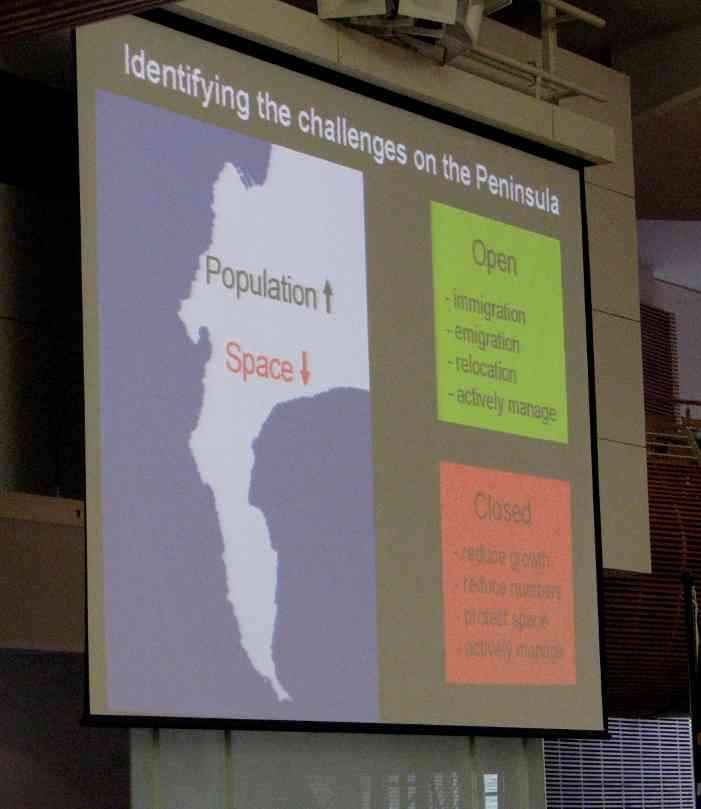
It has been questioned whether the baboons should be classified as a "closed population" as advocated in a BRU presentation at the "baboon expert workshop" (meaning they cannot be moved off the Peninsula), especially if once classified as such they are subsequently managed according to controversial criteria as recommended by BRU, including "reduction of growth" (alien vegetation) and "reduction of numbers" (baboons).
One BRU researcher, Tali Hoffman, produced maps of baboon home ranges after collecting data from bulky collars with GPS tracking devices worn by some baboons from 2008. (Some baboons are now also fitted with VHS collars that track the individual baboon's movements and raiding habits.)
The maps were claimed by BRU to be one of their most significant contributions to the management and conservation of the baboons and were presented to City authorities in 2009 for inclusion in the integrated development of the Peninsula.
However, the claim regarding the maps aiding baboon conservation appears ironic, given BRU's participation in the culling protocols that many feel pose a threat to baboon conservation. Indeed, the collars have been used on male baboons to record their raiding pattern which can be used as evidence against them when under consideration for culling.
Peninsula baboons have shown little change in numbers in the last decade since legally protected, so any plans to cull them therefore become even more controversial.
In March 2011, 10 baboons died, including Fred who was culled for raiding and “aggression” and Captain Corelli who was also killed, when he was deemed to have lost a significant amount of weight and lacked teeth.
On 15 July 2011, Jimmy was culled. Permission had been given by the Wildlife Advisory Committee of CapeNature, based on the evidence presented to them for both Jimmy (Waterfall troop) and Oswald or TK8 (Tokai), to be culled. Both had worn collars. Collars track raiding patterns that forms part of evidence presented to WAC, thus making the use of collars appear to lend support to the “culling” rather than the “conservation” of baboons as had been claimed.
From March 25 to 15 July 2001, 3 male baboons were culled in terms of the protocols - 3 in just under a 4 month period. In terms of the 2000 Brownlie document, no baboons were culled in a decade.
TK7, previously known as Mike, a male baboon from the Tokai troop, was reported as "visiting" Lavender Hill in the press on 3 November, 2011. He was cage trapped. On the 9th November, there was no new information available. When a resident queried whether he was still alive they were told on the 18th that he had been "euthanized" as there were no troops with a "vacancy".
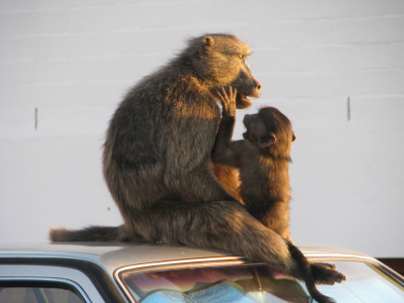
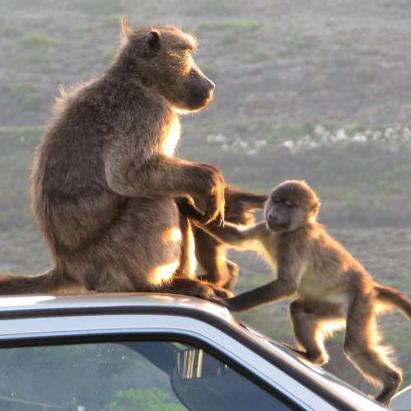

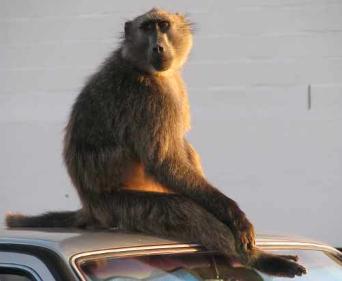
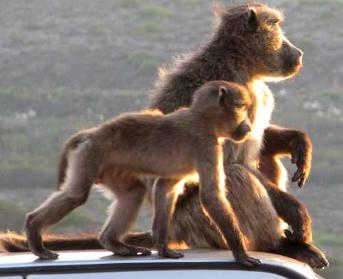


Elements taken from a sign by the City of Cape Town show doors must be locked by visitors and windows closed in order to prevent baboons gaining access to cars. Baboons must not be fed.
If some people feed baboons, they begin to think all people want to do the same and may even attempt to grab food from them - as has occurred in the parking lot of Cape Point reserve over the years.
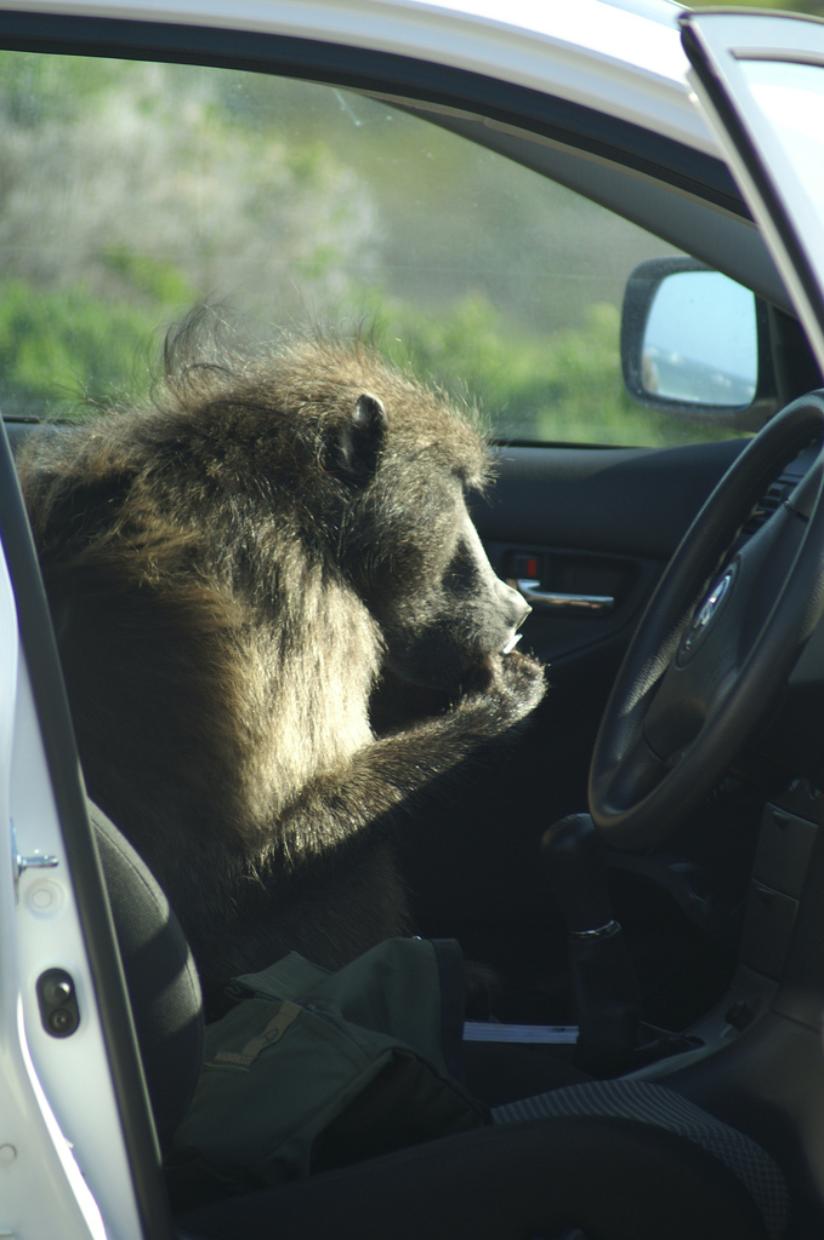
Photo Tim Ellis Flickr
When stopping in a baboon frequented areas, it is essential that car doors are LOCKED - not only shut - as they can be opened by baboons.
Lock your car doors - do not only shut them as baboons can open car doors!
This situation could easily have been avoided by locking the car doors and closing windows! While other visitors may laugh at baboons climbing into cars, and the reactions of the owners, they may not be as amused when a baboon climbs into their own unlocked car and takes their pizza or sandwiches - or even a bag containing a wallet or other valuables in search of food.
The baboon in the car would easily have been prevented from entering the car if the owner had locked - not only shut - the car door.
According to the photographer, the driver stopped on the way to Cape Point to take some photos when the male baboon "opened the back door and let himself in" causing the occupants to "rapidly exist via the front door!"
For the baboon, this is actually a dangerous situation as in terms of the individual raiders Protocol of 2010, entering a space occupied by humans, can lead to it being culled.
Below is an extract from the 2010 Protocol, in terms of which several baboons have been killed.
"Raiding baboon: a baboon which forages on human-derived food by entering a property or car with people inside or breaking into a building with or without people or attacking people directly (see definitions below). Raiding in this protocol does not include baboons feeding opportunistically on human derived food that is readily available within or immediately adjacent to their home range (e.g., open bins, discarded food items in public open spaces, unattended picnic-sites and open cars with no people and food on display)...."
"Enters property with people: the baboon enters a building (e.g. house, restaurant, shop) or confined garden while people are present and clearly visible to the baboon at the time of entry. The baboon thus chooses to reduce space between it and humans to obtain human-derived food items within a human modified habitat."
http://www.capenature.co.za/docs/1918/Protocol%20for%20raiding%20baboons%20(3).pdf
Though some may find it hard to believe baboons can open unlocked car doors, they have dextrous fingers and opposable thumbs like humans, making it easy for them to open car doors.
If a baboon does manage to gain entrance, leave it an exit route and do not confront it.
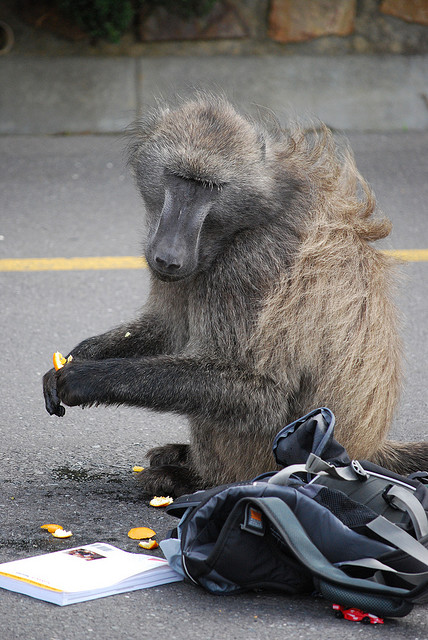
Photo by JS SChinker Flickr 

 Some rights reserved
Some rights reserved
Officials advise to remain calm if a baboon grabs personal belongings such as a handbag or rucksack. Never try and grab the bag back. This may well elicit an aggressive response if the baboon thinks there is food in the bag and wants to retain it. Officials advise that after examining contents to check for edibles, the baboon will lose interest and move away from the item, which can then be retrieved.
Where free-ranging baboons are found along scenic routes including from Simonstown to Cape Point and through to Scarborough, tourists should not carry food. Baboons have a good sense of smell and can smell food from a distance.
Do not attempt to access food from a vehicles' boot in areas like the Cape Point Reserve parking lot, well known for baboons' attempts to grab food from visitors. (Some believe stricter limits on visitors accessing food in reserve areas by reserve management should be applied as is similarly required from residents in personal baboon management in order to prevent food raids.)
Do not leave food visible in the car.
NEVER attempt to touch a baboon. Some tourists inadvisedly attempt to go close to baboons. Baboons are wild animals, not pets and should be treated with respect, so keep your distance, including from the youngsters. Males will rush to their protection if they show signs of distress or squeal.
There is a fine for feeding baboons.

Photo by vgh.media Flickr Some rights reserved 

When people stop vehicles to admire the view, watch baboons, spot whales in season, or take photos, baboons may take the opportunity to open unlocked car doors in search of food.

Photo of Fred by vgh.media Flickr Some rights reserved ![]()
![]()
Fred, who was culled in March, 2011 stands on car. It is essential to LOCK - not only shut - car doors and close windows to avoid baboons entering cars stopped along scenic routes, notably along the road from Simonstown to Cape Point and travelling towards Scarborough and Kommetjie.
Fred was not the only baboon in the troop that was able to open car doors, others include Merlin whom some are concerned may also be culled, given accusations of aggression to monitoring staff including a field manager being levelled against him, just as occurred before Fred wa culled. But then others may also be in danger of being culled. Residents who asked "Who's next?" as they did after Fred's culling in March, 2011, learned Jimmy and TK8 had been killed in July 2011. TK7 in November 2011.
Merlin together with Fred, Quondi (Ghundi), George, were a few of the baboons featured in 'Baboons wirh Bill Bailey.' George was killed by dogs a week after a meeting was convened by the City in Da Gama Park promoting a "vision" of total removal of baboons from urban areas and seeking input/resident approval on "tools" eg bearbangers and bullwhips as current methods were deemed not to be working, although this was correctly attributed by Jenni Trethowan at the meeting due to the lack of monitor training in assertive handling of the baboons and in using methods that did not work eg holding the line close to the urban area. She issued a challenge to train the monitors using Baboon Matters methods which have proven to be highly successful elsewhere in training monitors to be assertive - before aggressive "tools" were used. One resident suggested using electro shock collars around the necks of males if entering a house to raid so monitors could give them a "massive shock" - which proposal was reportedly to be "investigated". A security gate over an open door would prevent males entering the house.
Award winning film maker Trevor de Kock who made a documentary "City Slickers" about the Simonstown penguins is also making a production about the baboons using footage over several years.
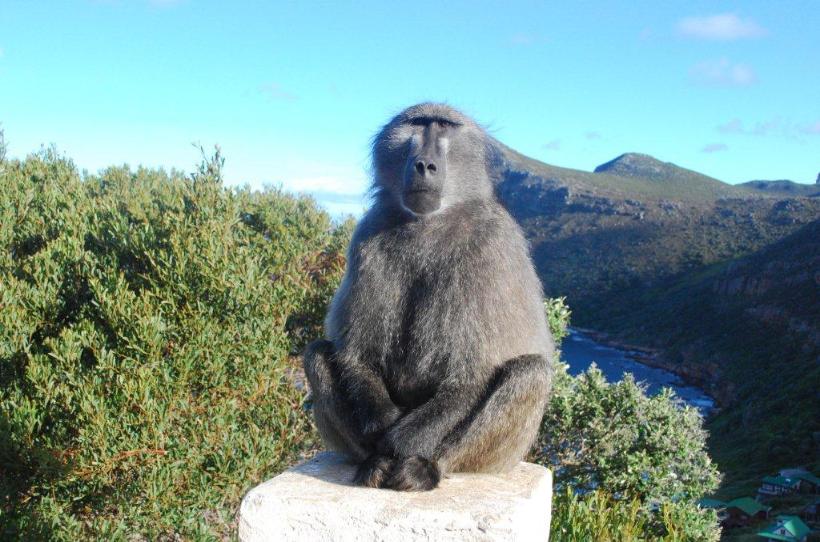
Photo of Fred of the Smitswinkel troop sitting above Smitswinkel Bay by Chad Chapman All rights reserved
While baboons are after food rather than seeking interaction with humans, the second culling protocol targets baboons for entering vehicles occupied by humans as it did Fred, alpha male of Smitswinkel, pictured above.
Human responsibility is required to prevent deliberately or inadvertently feeding baboons through failure to baboon-proof in areas adjoining or intersecting baboon home ranges.
All Content by site author Copyright 2009-2011
All Rights reserved L Thomas
No portion of content may be reproduced in any way without written permission
Individual Rights apply to FLICKR photos